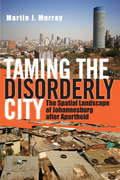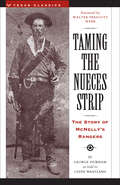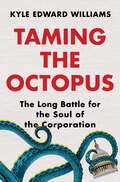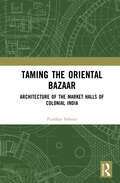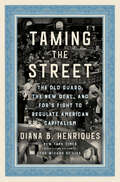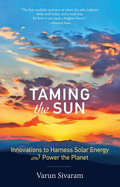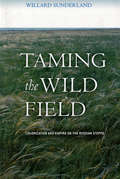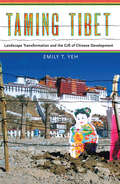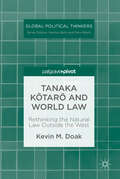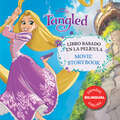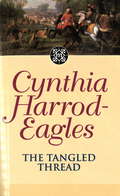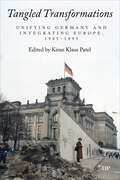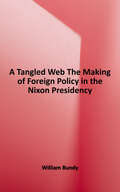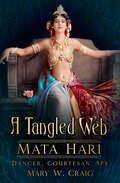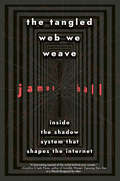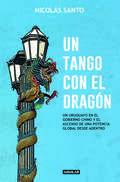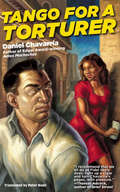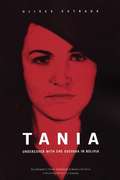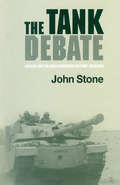- Table View
- List View
Taming the Disorderly City: The Spatial Landscape of Johannesburg after Apartheid
by Martin J. MurrayIn postapartheid Johannesburg, tensions of race and class manifest themselves starkly in struggles over "rights to the city." Real-estate developers and the very poor fight for control of space as the municipal administration steps aside, almost powerless to shape the direction of change. Having ceded control of development to the private sector, the Johannesburg city government has all but abandoned residential planning to the unpredictability of market forces. This failure to plan for the civic good—and the resulting confusion—is a perfect example of the entrepreneurial approaches to urban governance that are sweeping much of the Global South as well as the cities of the North.Martin J. Murray brings together a wide range of urban theory and local knowledge to draw a nuanced portrait of contemporary Johannesburg. In Taming the Disorderly City, he provides a focused intellectual and political critique of the often-ambivalent urban dynamics that have emerged after the end of apartheid. Exploring the behaviors of the rich and poor, each empowered in their own way, as they rebuild a new Johannesburg, we see the entrepreneurial city: high-rises, shopping districts, and gated communities surrounded by and intermingled with poverty. In graceful prose, Murray offers a compelling portrait of the everyday lives of the urban poor as seen through the lens of real-estate capitalism and revitalization efforts.
Taming the Elephant: Politics, Government, and Law in Pioneer California
by John F. Burns Richard J. OrsiLively, authoritative essays on the political history of California from the Gold Rush and the achievement of statehood through the end of the 19th century. The fourth and final volume in a series of essays on California history, co-published with the California State Historical Society.
Taming the Gods: Religion and Democracy on Three Continents
by Ian BurumaWhy religion must be separated from politics if democracy is to thrive around the worldFor eight years the president of the United States was a born-again Christian, backed by well-organized evangelicals who often seemed intent on erasing the church-state divide. In Europe, the increasing number of radicalized Muslims is creating widespread fear that Islam is undermining Western-style liberal democracy. And even in polytheistic Asia, the development of democracy has been hindered in some countries, particularly China, by a long history in which religion was tightly linked to the state.Ian Buruma is the first writer to provide a sharp-eyed look at the tensions between religion and politics on three continents. Drawing on many contemporary and historical examples, he argues that the violent passions inspired by religion must be tamed in order to make democracy work.Comparing the United States and Europe, Buruma asks why so many Americans—and so few Europeans—see religion as a help to democracy. Turning to China and Japan, he disputes the notion that only monotheistic religions pose problems for secular politics. Finally, he reconsiders the story of radical Islam in contemporary Europe, from the case of Salman Rushdie to the murder of Theo van Gogh. Sparing no one, Buruma exposes the follies of the current culture war between defenders of "Western values" and "multiculturalists," and explains that the creation of a democratic European Islam is not only possible, but necessary.Presenting a challenge to dogmatic believers and dogmatic secularists alike, Taming the Gods powerfully argues that religion and democracy can be compatible—but only if religious and secular authorities are kept firmly apart.
Taming the Imperial Imagination
by Martin J. BaylyTaming the Imperial Imagination marks a novel intervention into the debate on empire and international relations, and offers a new perspective on nineteenth-century Anglo-Afghan relations. Martin J. Bayly shows how, throughout the nineteenth century, the British Empire in India sought to understand and control its peripheries through the use of colonial knowledge. Addressing the fundamental question of what Afghanistan itself meant to the British at the time, he draws on extensive archival research to show how knowledge of Afghanistan was built, refined and warped by an evolving colonial state. This knowledge informed policy choices and cast Afghanistan in a separate legal and normative universe. Beginning with the disorganised exploits of nineteenth-century explorers and ending with the cold strategic logic of the militarised 'scientific frontier', this book tracks the nineteenth-century origins of contemporary policy 'expertise' and the forms of knowledge that inform interventions in Iraq, Afghanistan and elsewhere today.
Taming the Leviathan
by Jon ParkinThomas Hobbes is widely acknowledged as the most important political philosopher to have written in English. Originally published in 2007, Taming the Leviathan is a wide-ranging study of the English reception of Hobbes's ideas. In the first book-length treatment of the topic for over forty years, Jon Parkin follows the fate of Hobbes's texts (particularly Leviathan) and the development of his controversial reputation during the seventeenth century, revealing the stakes in the critical discussion of the philosopher and his ideas. Revising the traditional view that Hobbes was simply rejected by his contemporaries, Parkin demonstrates that Hobbes's work was too useful for them to ignore, but too radical to leave unchallenged. His texts therefore had to be controlled, their lessons absorbed and their author discredited. In other words the Leviathan had to be tamed. Taming the Leviathan significantly revised our understanding of the role of Hobbes and Hobbism in seventeenth-century England.
Taming the Nueces Strip: The Story of McNelly's Rangers (Texas Classics)
by George Durham Clyde Wantland&“Durham&’s account is modest and straightforward . . . has many lessons for anyone interested in the history of the Old West, leadership or law enforcement.&” —American West Review Only an extraordinary Texas Ranger could have cleaned up bandit-plagued Southwest Texas, between the Nueces River and the Rio Grande, in the years following the Civil War. Thousands of raiders on horseback, some of them Anglo-Americans, regularly crossed the river from Mexico to pillage, murder, and rape. Their main objective? To steal cattle, which they herded back across the Rio Grande to sell. Honest citizens found it almost impossible to live in the Nueces Strip. In desperation, the governor of Texas called on an extraordinary man, Captain Leander M. McNelly, to take command of a Ranger company and stop these border bandits. One of McNelly&’s recruits for this task was George Durham, a Georgia farm boy in his teens when he joined the &“Little McNellys,&” as the Captain&’s band called themselves. More than half a century later, it was George Durham, the last surviving &“McNelly Ranger,&” who recounted the exciting tale of taming the Nueces Strip to San Antonio writer Clyde Wantland. In Durham&’s account, those long-ago days are brought vividly back to life. Once again the daring McNelly leads his courageous band across Southwest Texas to victories against incredible odds. With a boldness that overcame their dismayingly small number, the McNellys succeeded in bringing law and order to the untamed Nueces Strip—succeeded so well that they antagonized certain &“upright&” citizens who had been pocketing surreptitious dollars from the bandits&’ operations. &“The reader seems to smell the acrid gunsmoke and to hear the creak of saddle leather.&” —Southwestern Historical Quarterly
Taming the Octopus: The Long Battle for the Soul of the Corporation
by Kyle Edward WilliamsThe untold story of how efforts to hold big business accountable changed American capitalism. Recent controversies around environmental, social, and governance (ESG) investing and “woke capital” evoke an old idea: the Progressive Era vision of a socially responsible corporation. By midcentury, the notion that big business should benefit society was a consensus view. But as Kyle Edward Williams’s brilliant history, Taming the Octopus, shows, the tools forged by New Deal liberals to hold business leaders accountable, such as the Securities and Exchange Commission, narrowly focused on the financial interests of shareholders. This inadvertently laid the groundwork for a set of fringe views to become dominant: that market forces should rule every facet of society. Along the way, American capitalism itself was reshaped, stripping businesses to their profit-making core. In this vivid and surprising history, we meet activists, investors, executives, and workers who fought over a simple question: Is the role of the corporation to deliver profits to shareholders, or something more? On one side were “business statesmen” who believed corporate largess could solve social problems. On the other were libertarian intellectuals such as Milton Friedman and his oft-forgotten contemporary, Henry Manne, whose theories justified the ruthless tactics of a growing class of corporate raiders. But Williams reveals that before the “activist investor” emerged as a capitalist archetype, Civil Rights groups used a similar playbook for different ends, buying shares to change a company from within. As a rising tide of activists pushed corporations to account for societal harms from napalm to environmental pollution to inequitable hiring, a new idea emerged: that managers could maximize value for society while still turning a maximal profit. This elusive ideal, “stakeholder capitalism,” still dominates our headlines today. Williams’s necessary history equips us to reconsider democracy’s tangled relationship with capitalism.
Taming the Oriental Bazaar: Architecture of the Market-Halls of Colonial India
by Pushkar SohoniTaming the Oriental Bazaar examines the public market-hall as a key architectural feature of colonial South Asia. Representing a transition in the architectural programme, these buildings were meant to be monuments and markers of modernity in South Asia. The book: • Explores how market-halls became an essential feature of colonial settlements from the mid-nineteenth through the mid-twentieth centuries; • Discusses public health policies and legislations central to the concerns of market-hall sanitation; • Reviews the elements of modernity, including institutions and systems established in the nineteenth century as India went from Company to Crown; • Studies the specific circumstances and histories of market halls in the towns and cities of Bengaluru, Vadodara, Mumbai, Kolkata, Hyderabad, Karachi, Lahore, Chennai, Pune, and others. A key text in the study of colonial architecture, this book will be of interest to students, researchers as well as general readers of architecture, colonialism, history of architecture, history of medicine, public health, urbanism, and South Asian studies.
Taming the Street: The Old Guard, the New Deal, and FDR's Fight to Regulate American Capitalism
by Diana B. HenriquesThe &“extraordinary&” (New York Times Book Review, Editors&’ Choice) story of FDR&’s fight for the soul of American capitalism—from award-winning journalist Diana B. Henriques, author of The Wizard of Lies: Bernie Madoff and the Death of Trust&“I thought I was well versed in the New Deal, but it turns out I knew next to nothing. Diana Henriques&’s chronicle is meticulous, illuminating, and riveting.&”—Kurt Andersen, New York Times bestselling author of Evil Geniuses and FantasylandTaming the Street describes how President Franklin D. Roosevelt battled to regulate Wall Street in the wake of the 1929 stock market crash and the ensuing Great Depression. With deep reporting and vivid storytelling, Diana B. Henriques takes readers back to a time when America&’s financial landscape was a jungle ruled by the titans of vast wealth, largely unrestrained by government. Roosevelt ran for office in 1932 vowing to curb that ruthless capitalism and make the world of finance safer for ordinary savers and investors. His deeply personal campaign to tame the Street is one of the great untold dramas in American history. Success in this political struggle was far from certain for FDR and his New Deal allies, who included the political dynasty builder Joseph P. Kennedy and the future Supreme Court justice William O. Douglas. Wall Street&’s old guard, led by New York Stock Exchange president Richard Whitney, fought every new rule to the &“last legal ditch.&” That clash—between two sharply different visions of financial power and federal responsibility—has shaped how &“other people&’s money&” is managed in the United States to this day. As inequality once again reaches Jazz Age levels, Henriques brings to life a time when the system worked—an idealistic moment when ordinary Americans knew what had to be done and supported leaders who could do it. A vital history and a riveting true-life thriller, Taming the Street raises an urgent and troubling question: What does capitalism owe to the common good?
Taming the Sun: Innovations to Harness Solar Energy and Power the Planet (The\mit Press Ser.)
by Varun SivaramHow solar could spark a clean-energy transition through transformative innovation—creative financing, revolutionary technologies, and flexible energy systems.Solar energy, once a niche application for a limited market, has become the cheapest and fastest-growing power source on earth. What's more, its potential is nearly limitless—every hour the sun beams down more energy than the world uses in a year. But in Taming the Sun, energy expert Varun Sivaram warns that the world is not yet equipped to harness erratic sunshine to meet most of its energy needs. And if solar's current surge peters out, prospects for replacing fossil fuels and averting catastrophic climate change will dim.Innovation can brighten those prospects, Sivaram explains, drawing on firsthand experience and original research spanning science, business, and government. Financial innovation is already enticing deep-pocketed investors to fund solar projects around the world, from the sunniest deserts to the poorest villages. Technological innovation could replace today's solar panels with coatings as cheap as paint and employ artificial photosynthesis to store intermittent sunshine as convenient fuels. And systemic innovation could add flexibility to the world's power grids and other energy systems so they can dependably channel the sun's unreliable energy.Unleashing all this innovation will require visionary public policy: funding researchers developing next-generation solar technologies, refashioning energy systems and economic markets, and putting together a diverse clean energy portfolio. Although solar can't power the planet by itself, it can be the centerpiece of a global clean energy revolution.A Council on Foreign Relations Book
Taming the Wild Field: Colonization and Empire on the Russian Steppe
by Willard SunderlandStretching from the tributaries of the Danube to the Urals and from the Russian forests to the Black and Caspian seas, the vast European steppe has for centuries played very different roles in the Russian imagination. To the Grand Princes of Kiev and Muscovy, it was the "wild field," a region inhabited by nomadic Turko-Mongolic peoples who repeatedly threatened the fragile Slavic settlements to the north. For the emperors and empresses of imperial Russia, it was a land of boundless economic promise and a marker of national cultural prowess. By the mid-nineteenth century the steppe, once so alien and threatening, had emerged as an essential, if complicated, symbol of Russia itself. Traversing a thousand years of the region's history, Willard Sunderland recounts the complex process of Russian expansion and colonization, stressing the way outsider settlement at once created the steppe as a region of empire and was itself constantly changing. The story is populated by a colorful array of administrators, Cossack adventurers, Orthodox missionaries, geographers, foreign entrepreneurs, peasants, and (by the late nineteenth century) tourists and conservationists. Sunderland's approach to history is comparative throughout, and his comparisons of the steppe with the North American case are especially telling. Taming the Wild Field eloquently expresses concern with the fate of the world's great grasslands, and the book ends at the beginning of the twentieth century with the initiation of a conservation movement in Russia by those appalled at the high environmental cost of expansion.
Taming Tibet: Landscape Transformation and the Gift of Chinese Development
by Emily T. YehThe violent protests in Lhasa in 2008 against Chinese rule were met by disbelief and anger on the part of Chinese citizens and state authorities, perplexed by Tibetans apparent ingratitude for the generous provision of development. In Taming Tibet, Emily T. Yeh examines how Chinese development projects in Tibet served to consolidate state space and power. Drawing on sixteen months of ethnographic fieldwork between 2000 and 2009, Yeh traces how the transformation of the material landscape of Tibet between the 1950s and the first decade of the twenty-first century has often been enacted through the labor of Tibetans themselves. Focusing on Lhasa, Yeh shows how attempts to foster and improve Tibetan livelihoods through the expansion of markets and the subsidized building of new houses, the control over movement and space, and the education of Tibetan desires for development have worked together at different times and how they are experienced in everyday life. The master narrative of the PRC stresses generosity: the state and Han migrants selflessly provide development to the supposedly backward Tibetans, raising the living standards of the Han s little brothers. Arguing that development is in this context a form of indebtedness engineering, Yeh depicts development as a hegemonic project that simultaneously recruits Tibetans to participate in their own marginalization while entrapping them in gratitude to the Chinese state. The resulting transformations of the material landscape advance the project of state territorialization. Exploring the complexity of the Tibetan response to and negotiations with development, Taming Tibet focuses on three key aspects of China s modernization: agrarian change, Chinese migration, and urbanization. Yeh presents a wealth of ethnographic data and suggests fresh approaches that illuminate the Tibet Question.
Tanaka Kōtarō and World Law: Rethinking the Natural Law Outside the West (Global Political Thinkers)
by Kevin M. DoakThis book explores one of the 20th century’s most consequential global political thinkers and yet one of the most overlooked. Tanaka Kōtarō (1890-1974) was modern Japan’s pre-eminent legal scholar and jurist. Yet because most of his writing was in Japanese, he has been largely overlooked outside of Japan. His influence in Japan was extraordinary: the only Japanese to serve in all three branches of government, and the longest serving Chief Justice of the Supreme Court. His influence outside Japan also was extensive, from his informal diplomacy in Latin America in the prewar period to serving on the International Court of Justice in the 1960s. His stinging dissent on that court in the 1966 South-West Africa Case is often cited even today by international jurists working on human rights issues. Above and beyond these particular lines of influence, Tanaka outlined a unique critique of international law as inherently imperialistic and offered as its replacement a theory of World Law (aka “Global Law”) based on the Natural Law. What makes Tanaka’s position especially notable is that he defended the Natural Law not as a European but from his vantage point as a Japanese jurist, and he did so not from public law, but from his own expertise in private law. This work introduces Tanaka to a broader, English-reading public and hopes thereby to correct certain biases about the potential scope of ideas concerning human rights, universality of reason, law and ethics.
Tangled Movie Storybook / Libro basado en la película (English-Spanish)
by Disney Book GroupExperience Disney's Tangled like never before in this English-Spanish bilingual storybook. Únete a Rapunzel al abandonar su torre por primera vez y emprender una aventura mágica que cambiará su vida para siempre. Join Rapunzel as she leaves her tower for the first time and embarks on a magical adventure that will change her life forever.
The Tangled Thread: The Morland Dynasty, Book 10 (Morland Dynasty #10)
by Cynthia Harrod-Eagles1788: the bloody revolution in France causes upheaval in the Morland family.Henri-Marie Fitzjames Stuart, bastard offshoot of the Morland family, strives to protect his daughter, Heloise, his mistress, Marie-France, and their son Morland. To this end, he binds Heloise to a loveless marriage with a Revolutionary, and allies himself with the great Danton. But in the bloodbath of the guillotine and the fall of Danton, Henri-Marie loses his head and Heloise flees to England.She is welcomed with open arms by the family, and in Yorkshire Jemima proudly witnesses three marriages amongst her turbulent brood.At least three may be an heir to Morland Place, but the seeds of disaster have already been sown.
The Tangled Thread: The Morland Dynasty, Book 10 (Morland Dynasty #10)
by Cynthia Harrod-Eagles1788: the bloody revolution in France causes upheaval in the Morland family.Henri-Marie Fitzjames Stuart, bastard offshoot of the Morland family, strives to protect his daughter, Heloise, his mistress, Marie-France, and their son Morland. To this end, he binds Heloise to a loveless marriage with a Revolutionary, and allies himself with the great Danton. But in the bloodbath of the guillotine and the fall of Danton, Henri-Marie loses his head and Heloise flees to England.She is welcomed with open arms by the family, and in Yorkshire Jemima proudly witnesses three marriages amongst her turbulent brood. At least three may be an heir to Morland Place, but the seeds of disaster have already been sown.
Tangled Transformations: Unifying Germany and Integrating Europe, 1985–1995 (German and European Studies #54)
by Kiran Klaus PatelTangled Transformations presents a historical analysis of the interplay between German unification and European integration from the mid-1980s to the mid-1990s. Building on freshly released documents, the book’s sixteen chapters explore constellations in which the two processes accelerated and informed one another. The book highlights the role of Germany’s neighbours to the east, with chapters discussing the cotransformation between East and West as well as chapters dedicated to Poland, Romania, and Hungary. It sheds new light on the two interrelated processes by examining the role of Germany’s most important Western neighbours and partners: the United States, the United Kingdom, France, and Italy. The book pays particular attention to the role of the European Commission as well as to monetary and industrial policy. It also moves beyond the economic sphere by discussing foreign and security policy issues, justice and home affairs, German debates about European integration at the time, and the significance of the German federal states. Ultimately, Tangled Transformations demonstrates the strong interlinkages between German unification and European integration.
A Tangled Web: The Making of Foreign Policy in the Nixon Presidency
by William P. BundyAn authoritative historical assessment of American foreign policy in a crucial postwar decade. William Bundy's magisterial book focuses on the controversial record of Richard Nixon's and Henry Kissinger's often overpraised foreign policy of 1969 to 1973, an era that has rightly been described as the hinge on which the last half of the century turned. Bundy's principled, clear-eyed assessment in effect pulls together all the major issues and events of the thirty-year span from the 1940s to the end of the Vietnam War, and makes it clear just how dangerous the consequences of Nixon and Kissinger's deceptive modus operandi were.
A Tangled Web: Dancer, Courtesan, Spy
by Mary CraigIn this new biography, published to coincide with the 100th anniversary of her execution, Mata Hari is revealed in all of her flawed eccentricity; a woman whose adult life was a fantastical web of lies, half-truths and magnetic sexuality that captivated men. Following the death of a young son and a bitter divorce, Mata Hari reinvented herself as an exotic dancer in Paris, before finally taking up the life of a courtesan. She could have remained a half-forgotten member of France’s grande horizontale were it not for the First World War and her disastrous decision to become embroiled in espionage. What happened next was part farce and part tragedy that ended in her execution in October 1917. Recruited by both the Germans and the French as a spy, Mata Hari – codenamed H-21 – was also almost recruited by the Russians. But the harmless fantasies and lies she had told on stage had become part of the deadly game of double agents during wartime. Struggling with the huge cost of war, the French authorities needed to catch a spy. Mata Hari, the dancer, the courtesan, the fantasist, became the prize catch.
The Tangled Web We Weave: Inside The Shadow System That Shapes the Internet
by James BallWe all see what the internet does and increasingly don't like it, but do we know how and more importantly who makes it work that way? That's where the real power lays... <P><P>The internet was supposed to be a thing of revolutions. As that dream curdles, there is no shortage of villains to blame--from tech giants to Russian bot farms. But what if the problem is not an issue of bad actors ruining a good thing? What if the hazards of the internet are built into the system itself? <P><P>That's what journalist James Ball argues as he takes us to the root of the problem, from the very establishment of the internet's earliest protocols to the cables that wire it together. He shows us how the seemingly abstract and pervasive phenomenon is built on a very real set of materials and rules that are owned, financed, designed and regulated by very real people. <P><P>In this urgent and necessary book, Ball reveals that the internet is not a neutral force but a massive infrastructure that reflects the society that created it. And making it work for--and not against--us must be an endeavor of the people as well.
Un tango con el dragón: Un uruguayo en el gobierno chino y el ascenso de una potencia global desde adentro
by Nicolás Santo<P>La educación, la cultura, el gobierno y el crecimiento de China a nivel global son expuestos a través de la experiencia personal del autor, residente y unos de los principales referentes de las relaciones entre China y Uruguay. <P>En tiempos en que América Latina se enfrenta al desafío de transitar hacia la integralidad de una asociación estratégica con una China que ha irrumpido como socio comercial clave, la lectura de Un tango con el dragón viene a aportar la visión "desde adentro" de un profesional uruguayo que mira a China sin prejuicios y que siente que en este vínculo hay mucho de "futuro" y de "ganar-ganar". <P>Pero, sobre todo, este relato nos invita a zambullirnos en el vértigo de los cambios constantes que se suceden en un país que no para de mutar, crecer y transformarse y es una llave para que uruguayos y latinoamericanos nos animemos a estudiar más sobre China y a detectar las posibilidades que se abren para trabajar juntos. <P>FERNANDO LUGRIS, EMBAJADOR DE URUGUAY ANTE EL GOBIERNO DE LA REPÚBLICA POPULAR CHINA Nicolás Santo brinda una perspectiva única de cómo el ascenso de China está transformando el orden mundial y de cómo China aprende del resto del mundo, habiendo sido parte de un experimento pionero que lo puso en el corazón de uno de los gobiernos locales más dinámicos de China. <P>EN BLAND, CORRESPONSAL DEL FINANCIAL TIMES EN EL SUR DE CHINA Y AUTOR DEL LIBRO GENERATION HK No debe haber otro uruguayo capaz de entender mejor la complejidad de la China actual, ni lo que nos falta a los latinoamericanos para lograr una integración económica más rica con la principal potencia emergente del mundo. Lectura obligada para políticos, empresarios y profesionales con ambición global. <P>MARTÍN AGUIRRE, DIRECTOR DEL DIARIO EL PAÍS Un tango con el dragón debe estar en la biblioteca de todo empresario latinoamericano que quiera entender las claves del éxito en los negocios con China. <P>VÍCTOR CADENA, VICEPRESIDENTE EJECUTIVO DE LA CÁMARA DE COMERCIO DE MÉXICO EN CHINA (MEXCHAM)
Tango for a Torturer
by Daniel ChavarríaA former revolutionary plots revenge, in this &“superior crime novel&” from an Edgar Award–winning author &“as adept at comedy as he is at tragedy&” (Publishers Weekly, starred review). Aldo Bianchi, a former Argentine revolutionary now living in Italy, travels to Havana, Cuba. There, he meets the beautiful Bini, a sultry student with great charm and panache working the hotels—and discovers that his nemesis, the Uruguayan military torturer Alberto Ríos, is living in the country as well, under a false identity. Putting his tropical holiday on hold, Bianchi goes on the hunt for his sadistic enemy, in this &“unusual political thriller . . . By turns bawdy, funny, dark, cheerful, learned, and madcap, populated with memorable characters&” from a winner of both an Edgar and a Dashiell Hammett Award (Booklist).
Tania: Undercover with Che Guevara in Bolivia
by Ulises EstradaThe story of the Cuban undercover agent sent to Bolivia in advance of Che's arrival, told by a key participant in the revolutionary movement in Latin America. Ulises Estrada was the principal organizer of Che's guerrilla mission to Bolivia and the man who trained Tania in her position as Cuba's Bolivian spy. Tania, born Haydee Tamara Bunke to German Jewish refugees in Argentina, became one of Cuba's most successful agents, penetrating Bolivia's high society and attaining direct contact with the President. She was killed in the 1967 ambush of Che's guerrilla group.
The Tank Debate: Armour and the Anglo-American Military Tradition
by John StoneIn The Tank Debate, John Stone highlights the equivocal position that armour has traditionally occupied in Anglo-American thought, and explains why - despite frequent predictions to the contrary - the tank has remained an important instrument of war. This book provides a timely and provocative study of the tank's developmental history, against the changing background of Anglo-American military thought.
Tanks on the Streets?: The Battle of George Square, Glasgow, 1919
by Louise Heren Gordon BarclayAt 12.08pm on Friday 31 January 1919, Margaret Buchanan drives her tram into George Square in Glasgow’s city center. She slows down to avoid the youths and men holding their arms up to stop her; some even jump onto the front of her tram. Swirling around her tram is a sea of heavy-coated men who have been on strike since Monday, demanding a reduction to a forty-hour working week. Crucially, the tram workers have not joined the strike; they are being abused as ‘scabs’. Constables and officers of Glasgow’s police force use their hands to try to part the crowd to allow the tram to proceed, but their efforts fail and batons are drawn. Within minutes, the violence will have spread across and beyond the Square; men will have been injured; the Sheriff will have read the Riot Act; strike leaders will lie stunned and bleeding inside the City Chambers; policemen and protestors will lie beaten in the streets. The violence and destruction in the Square, the streets to the north and south, in Glasgow Green and even south of the River Clyde, involves thousands of men. The city authorities believe the situation is beyond the control of the outnumbered police; the Sheriff sends a message to the local army commander requesting assistance. For the first time in history, tanks will be dispatched as ‘military aid to the civil power’. They will be accompanied by 10,000 soldiers. At approximately 12.30pm on Friday 31 January 1919, a century of myth-making commences. Using thousands of pages of court papers, memoirs and news reports, this book is the first attempt to tell the story of what happened in day-by-day detail.
